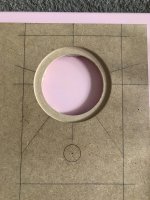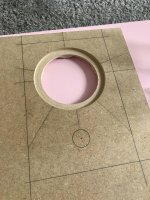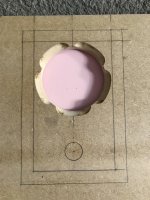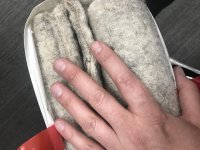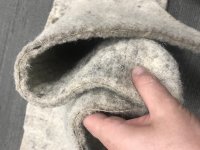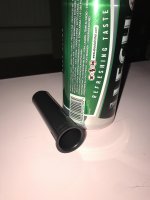The pensil has the greater acoustic efficiency, with a little more gain & a flatter impedance curve. The smaller box has a lower Fb, with a little less gain & is a more reactive load, albeit not an especially reactive design in outright terms. I see no advantage in folding it up though.
The folding is merely me trying to make it ergonomic to my environment, I wouldn't tamper with the design fundamentals.
I have poor quality uneven real wood floors so making a heavy base (be it for GMs proposal or the MLTL) makes sense to me. The compact MLTLs for the 6.2s I have are forever being nudged or moved by my cat (yes, really) so making the design weightier is beneficial in more ways than one.
Scott, is the damping type critical to the design? Polyfill isn't a listed option and I have lots of polyfill spare. I will plump for your t commendations if it isn't appropriate for this design in particular.
I have poor quality uneven real wood floors so making a heavy base (be it for GMs proposal or the MLTL) makes sense to me. The compact MLTLs for the 6.2s I have are forever being nudged or moved by my cat (yes, really) so making the design weightier is beneficial in more ways than one.
Scott, is the damping type critical to the design? Polyfill isn't a listed option and I have lots of polyfill spare. I will plump for your t commendations if it isn't appropriate for this design in particular.
Clamping it to a heavy plinth like an oversized slab of granite, marble &c. will do a similar job for small floorstanders. If you are supporting with a subwoofer it will be inferior to GMs smaller box though, so as noted, if that is what you are doing I wouldn't mess about; I'd just build that.
Note that to a point you change some of the design fundamentals by moving the vent significantly away from the floor. While not critical in this case, especially if supporting with additional LF drivers (in which case the additional complexity / extension is largely valueless) it's a point to keep in mind in a macro sense.
Note that to a point you change some of the design fundamentals by moving the vent significantly away from the floor. While not critical in this case, especially if supporting with additional LF drivers (in which case the additional complexity / extension is largely valueless) it's a point to keep in mind in a macro sense.
Graham,
Regarding damping, my understanding is that Scott's MLTL design recommends something like this to line the internal faces of the speaker cabinet:
Swaledale 54 Pure Wool Carpet Underlay.
Maybe Scott can confirm?
Regarding damping, my understanding is that Scott's MLTL design recommends something like this to line the internal faces of the speaker cabinet:
Swaledale 54 Pure Wool Carpet Underlay.
Maybe Scott can confirm?
A quality natural fiber carpet underlay (wool or jute) in the appropriate thickness is very effective; SAE F10 - F13 rated acoustic felt are effective but at a price which can be difficult to justify for this applications. Ultratouch recycled denim is also effective but can be harder to get and some of the better densities for acoustic absorbtion purposes aren't currently available (or not last I checked). Acoustic fiberglass board is probably the best of the lot from a performance perspective, but again, isn't always as easy to get hold of.
Last edited:
BS4060 is the equivalent British standard to the American SAE set of felt standards for those who are interested. The felt I use is not SAE but is equivalent.
Baffle layout and routing done for GM's plan!
Scallop beveled and sanded smooth. Flush mount rabbet cut to 4mm deep to leave the driver 2mm proud (allowing 1mm for gasket).
Internal dimensions which incorporate port, driver (250ml) and bracing volumes: 120mm x 160mm x 195mm.
Quick question, will the port have any difference mount on the front or back? They will be positioned on the corner of a fireplace with an alcove that is about 40cm deep on both sides.
As always, any thoughts welcome!
Scallop beveled and sanded smooth. Flush mount rabbet cut to 4mm deep to leave the driver 2mm proud (allowing 1mm for gasket).
Internal dimensions which incorporate port, driver (250ml) and bracing volumes: 120mm x 160mm x 195mm.
Quick question, will the port have any difference mount on the front or back? They will be positioned on the corner of a fireplace with an alcove that is about 40cm deep on both sides.
As always, any thoughts welcome!
Attachments
Generally speaking it doesn't usually matter unless really close to wall, but close to something as massive/dense as a fireplace combined with its cavity will for better or worse enhance vent output, so you may need to do a bit [more] of any vent damping required than for front firing.
GM
GM
Many thanks, is the damping as described by you in this thread correct?
Port Damping
Port Damping
Generally speaking it doesn't usually matter unless really close to wall, but close to something as massive/dense as a fireplace combined with its cavity will for better or worse enhance vent output, so you may need to do a bit [more] of any vent damping required than for front firing.
GM
You're welcome!
Yes, and something in retrospect that I didn't make very clear is that stuffing a vent makes it highly resistive [acoustic shelving resistor], hence the broadband drop that JAG mentions whereas the stretched material over the vent opening moves it towards a diaphragmatic absorber, mostly damping its fundamental and of course lowering its harmonic output as a consequence.
GM
Yes, and something in retrospect that I didn't make very clear is that stuffing a vent makes it highly resistive [acoustic shelving resistor], hence the broadband drop that JAG mentions whereas the stretched material over the vent opening moves it towards a diaphragmatic absorber, mostly damping its fundamental and of course lowering its harmonic output as a consequence.
GM
Thanks! Front firing port it is then, though, it is great to know these techniques should they be needed. This is, by far, the project that has taught me the most so far!
Picked up a Tesco bag of wool at my local rug shop. It's quite thick and smells of sheep. About 13mm, is it too heavy handed for the vented design? It can be de-laminated. Maybe I should just use it sparingly and measure the results?
Picked up a Tesco bag of wool at my local rug shop. It's quite thick and smells of sheep. About 13mm, is it too heavy handed for the vented design? It can be de-laminated. Maybe I should just use it sparingly and measure the results?
You're welcome!
Yes, and something in retrospect that I didn't make very clear is that stuffing a vent makes it highly resistive [acoustic shelving resistor], hence the broadband drop that JAG mentions whereas the stretched material over the vent opening moves it towards a diaphragmatic absorber, mostly damping its fundamental and of course lowering its harmonic output as a consequence.
GM
Attachments
You're welcome!
Would be for me as I prefer fiberglass insulation's damping properties combined with vent damping [if required], but many on the various forums prefer [much] denser materials, so ideally one should test to find what works best overall in the intended app or just use it knowing that you're in the majority 😉.
That said, you could do like the pioneers did when using it in vented alignments, i.e. just covering about 70% of the top, back and one side panel down to just above the vent.
Another option is to cover just the top and vertically suspend a loose hanging 'blanket' diagonally down to just above the vent, which BTW works well for damping large vents such as the terminus of the BIB for instance 😉.
GM
Would be for me as I prefer fiberglass insulation's damping properties combined with vent damping [if required], but many on the various forums prefer [much] denser materials, so ideally one should test to find what works best overall in the intended app or just use it knowing that you're in the majority 😉.
That said, you could do like the pioneers did when using it in vented alignments, i.e. just covering about 70% of the top, back and one side panel down to just above the vent.
Another option is to cover just the top and vertically suspend a loose hanging 'blanket' diagonally down to just above the vent, which BTW works well for damping large vents such as the terminus of the BIB for instance 😉.
GM
Thanks. I'll bare in mind all of these suggested routes. Scott and Planet 10 seem to do things similar with internal damping with only 3 walls in many of their plans.
I suppose no one lands on their preferred method or material first time so I'll suck it and see!
I suppose no one lands on their preferred method or material first time so I'll suck it and see!
You're welcome!
Would be for me as I prefer fiberglass insulation's damping properties combined with vent damping [if required], but many on the various forums prefer [much] denser materials, so ideally one should test to find what works best overall in the intended app or just use it knowing that you're in the majority 😉.
That said, you could do like the pioneers did when using it in vented alignments, i.e. just covering about 70% of the top, back and one side panel down to just above the vent.
Another option is to cover just the top and vertically suspend a loose hanging 'blanket' diagonally down to just above the vent, which BTW works well for damping large vents such as the terminus of the BIB for instance 😉.
GM
.....and I the pioneers' as we all 'stand on the shoulders of giants' since there's been precious little inventive advancement in audio system [and especially speaker] design theory since the late 1920s that hasn't been due to advances in materials, manufacturing.
GM
GM
I was thinking earlier, whilst at work, a quote from Gracelands... "who am I to blow against the wind?" in respect to favoured techniques and choices and the last two comments. Scott, it is reassuring that you show your evolution and Greg, it is great to see a humble attitude!
Anyway, back to more scientific matters...
My ports arrived today and the diameter taper goes from23mm to about 22mm at the length I will cut them. From the suggested 25.4mm port diameter this shoots port velocity up from around 10.5ms to 14ms. Is this a critical error as I believe it only effects the response of the port not the driver as the driver should see the same system in place?
That velocity peak is at 46hz and is at 7ms by the time it reaches 90hz.
China needs to buy new a new ruler when it comes to measuring mail order products...
Anyway, back to more scientific matters...
My ports arrived today and the diameter taper goes from23mm to about 22mm at the length I will cut them. From the suggested 25.4mm port diameter this shoots port velocity up from around 10.5ms to 14ms. Is this a critical error as I believe it only effects the response of the port not the driver as the driver should see the same system in place?
That velocity peak is at 46hz and is at 7ms by the time it reaches 90hz.
China needs to buy new a new ruler when it comes to measuring mail order products...
Last edited:
Right, when vent mach gets much above 3-5% of the speed of sound in air [depending on the source], it will start loading up, causing audible chuffing, so 'sounds' like you're OK.
If it really loads up though, then it will shift tuning lower, but typically it will be so obviously distorted that folks normally lower the volume and/or change an EQ setting if available. Then again, the mobile audio crowd typically use grossly undersized vents and been known to crank them up higher to increase distortion. Known some HT folks to do it too, especially with a very well known brand, so I guess one man's distortion is another's special effects.
GM
If it really loads up though, then it will shift tuning lower, but typically it will be so obviously distorted that folks normally lower the volume and/or change an EQ setting if available. Then again, the mobile audio crowd typically use grossly undersized vents and been known to crank them up higher to increase distortion. Known some HT folks to do it too, especially with a very well known brand, so I guess one man's distortion is another's special effects.
GM
Last edited:
According to WinISD:
Purple is 25.4mm port
Green is 23mm port (with length adjusted accordingly reach equal tuning).
Since the port is smaller I may sand down the unflared end to match the 2mm flare on the factory formed end. Perhaps this may help minutely.
Can of polish beer for scale... (it's almost midnight here and fiance is in bed, hooray! ...)
Purple is 25.4mm port
Green is 23mm port (with length adjusted accordingly reach equal tuning).
Since the port is smaller I may sand down the unflared end to match the 2mm flare on the factory formed end. Perhaps this may help minutely.
Can of polish beer for scale... (it's almost midnight here and fiance is in bed, hooray! ...)
Picture?
dave
Attachments
- Status
- Not open for further replies.
- Home
- Loudspeakers
- Full Range
- MLTL Floorstanders for Alpair 7MS
